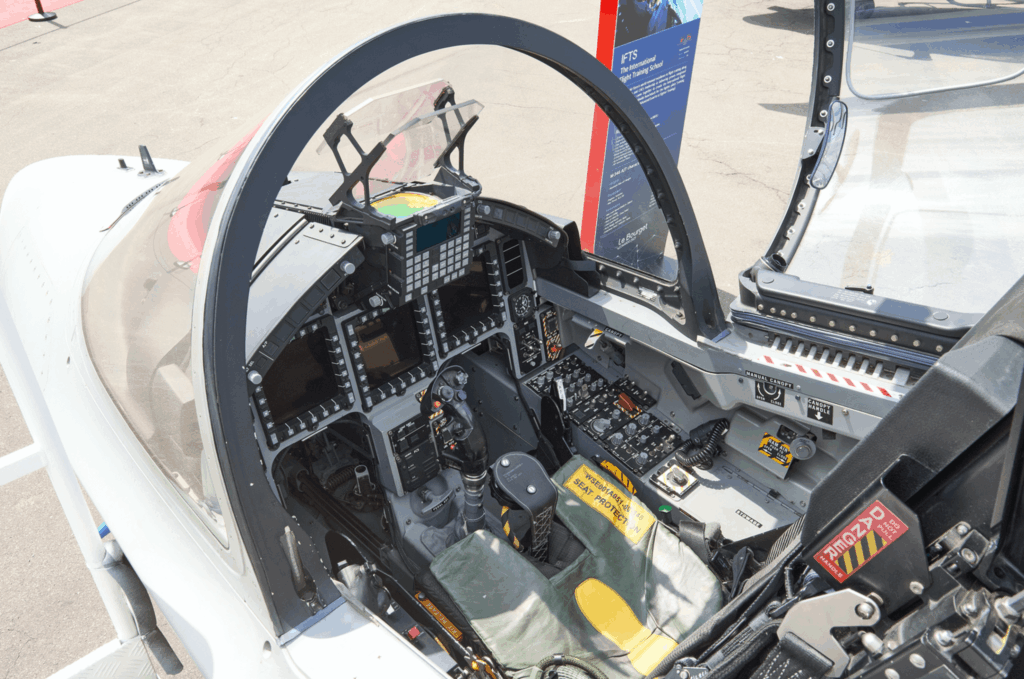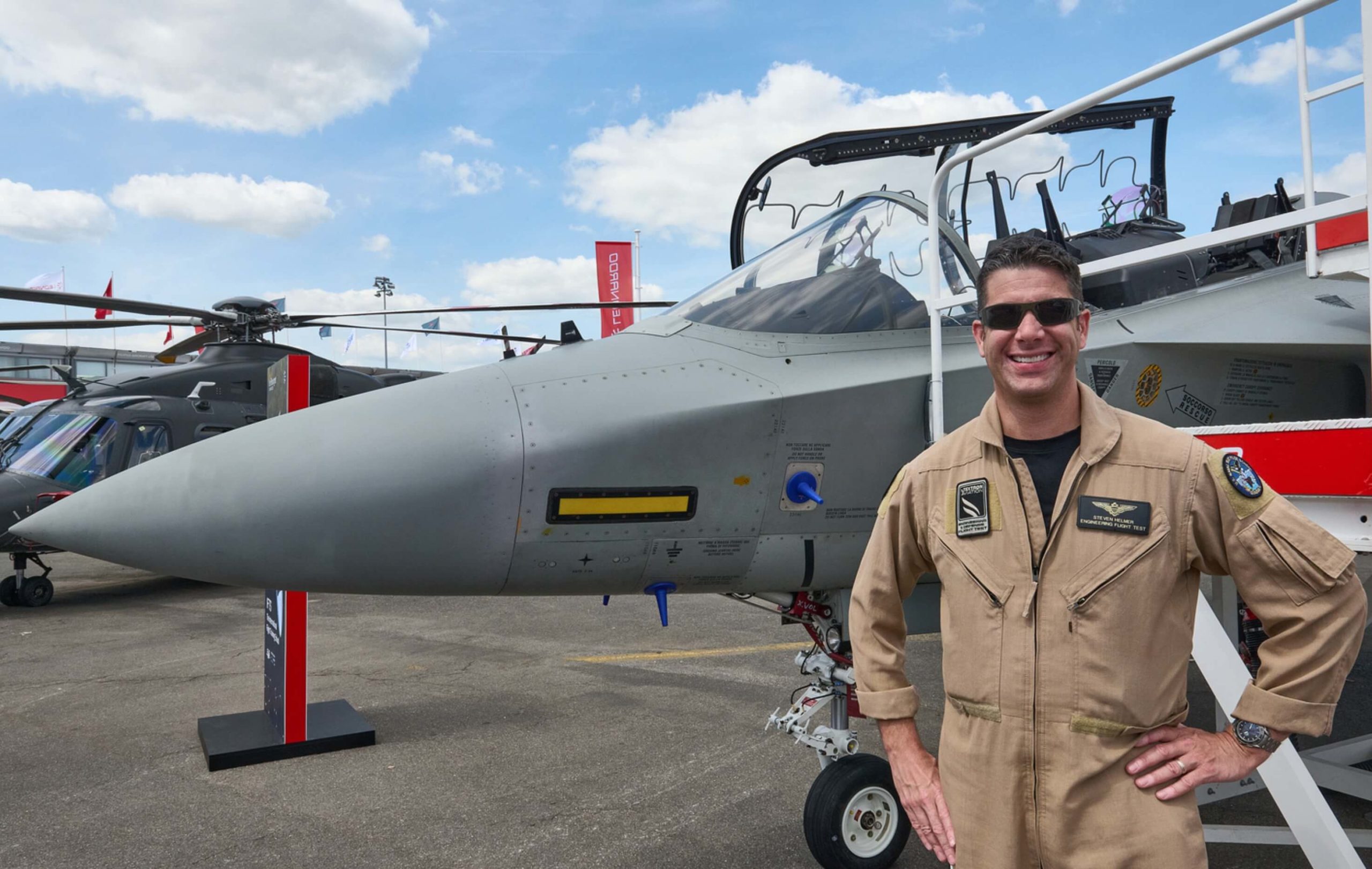By Pierre Tran
Le Bourget, France – Visitors climbing up to the open cockpit of the Leonardo M-346 could see the two distinctive tilted and overlapping glass screens which delivered a head up display (HUD) for pilots flying the advanced military jet trainer.
Steve “Jo Jo” Helmer, an engineering test pilot at Textron Aviation Defense, gave a quick visit of the cockpit of the M-346 on the static display at the outdoor stand of Leonardo, an Italian aerospace company, at the 55th Paris air show, which ran June 16 to 22.
Textron and Leonardo have partnered to pitch the M-346 in a U.S. navy competition to replace its fleet of Boeing T-45 Goshawk, a jet trainer based on the BAE Systems Hawk.
That HUD and an array of multifunction display screens made up the “glass cockpit” to train student pilots to fly advanced fighter jets such as the F-35. There were two combiner HUDs on the M-346, projecting essential flight information in the pilots’ field of vision, one for the student, and one for the instructor. Critical control of the jet was in the front seat.

Control touchpads gave the look and feel of a digital cockpit – both physical and technological – perhaps making generation Z students feel quite at home while flying a training combat mission.
The tail fin of the twin-engined jet displayed the green, white, and red of the Italian tricolori flag and the logo of the International Flight Training School, based in Sardinia, Italy. This model carried the tag T-346 A.
That static display of the M-346, transformed by a quick cockpit visit, indicated a lively world market for military trainer aircraft, both jet and turboprop.
The U.S. Navy tender was for around 200 aircraft, said Tom Webster, Textron Aviation vice president for global sales and strategy, in a deal estimated to be worth some $6 billion. That estimate was based on a unit price of some $20 mln for the jet trainer, 10 years of service support, avionics upgrade, and an extensive training package. The deal would be split around two thirds for Textron, one third for Leonardo.
Textron was proposing a complete training package, a “system of systems,” Helmer said, with a possible split of half flight hours and half training simulation. The trainee pilot could fly 200 flight hours, or maybe half that number, depending on the requirements. Training for complex missions on fourth, fifth and sixth generation fighters could be offered.
The U.S. navy’s competition for its undergraduate jet training system has attracted strong commercial interest. A pick of the training package and aircraft was expected in December 2026 or early 2027.
The M-346 was competing with the T-7 Red Hawk trainer pitched by the Boeing-Saab partnership, and the T-50 from Lockheed Martin-Korean Aerospace Industries.
Stavatti Aerospace, based in Niagara Falls, N.Y., pitched April 30 its SM-31T Stiletto, a concept aircraft, for the U.S. navy tender.
The U.S. air force has ordered some 350 T-7A jets, Saab, a Swedish aeronautics and arms company, said on its website.
There have been production delays in the T-7 program, Defense One website reported, with the U.S. air force postponing initial operation to 2028, a year behind previous plans. The service halved the 2025 order for the T-7, due to a tighter budget and delays in testing the jet.
Textron’s sales pitch included the M-346 fly-by-wire technology, and twin-engines. When asked about the higher cost of two engines, Webster pointed up greater safety, particularly in the light of engine failures on the T-45 Goshawk.
“No risk, no drama,” he said, with the M-346 as a jet off the shelf, cutting risk and time for the navy. There was mature technology on the M-346, he said, with some 10 years of training flights.
Israel has been flying the M-346 since 2014 to train fighter pilots. The Israeli air force has been flying the Lockheed Martin F-35 fighter since 2016.
Belgium was expected to decide soon on its aircraft training program, Webster said, probably in the next few months.
A Belgian team of air force and procurement officers visited October 2020 the Vienna head office of Diamond Aircraft, the company said in a Nov. 3 2020 statement. The Belgian delegation was looking for an aircraft and training package for its basic flight training course, to replace a fleet of Marchetti SF-260 planes. Diamond builds the Dart turboprop aircraft.
Meanwhile, there were some 14 countries flying the T-6 training aircraft, Webster said.
The Beechcraft T-6C Texan, built by Textron Aviation, was based on the Swiss Pilatus PC-9.
There was also a fighter attack (FA) version of the M-346, Helmer said, which flew much like a fourth-generation fighter jet.
Helmer, an ex-navy pilot with 15 years on the F-18, and Webster, an ex-air force F-16 pilot, exchanged a friendly interservice rivalry, as they presented the M-346.
There were more sales prospects in Europe, following higher perception of risk from Russia.
On fighter jets, Korea Aerospace Industries presented its FA-50 light combat version, as well as the KF-21, at the air show, Flight Daily News reported from the air show.
“This is going to be a good solution for the re-arming of Europe,” said Dong Haik Shin, vice president of international development at KAI, the show daily reported.
KAI won a 2022 order for its FA-50 from Poland, while Malaysia and the Philippines have also ordered the fighter attack jet, the report said. KAI was adapting the FA-50 to a single-seat model, replacing the back seat with a fuel tank and adding fuel in the rear fuselage.
France has upgraded its aircraft fleet to train fighter and transport pilots for the French air force, and navy.
The Direction Générale de l’Armement procurement office signed Dec. 31 2024 a contract with Babcock International France Aviation for its Mentor 2 pilot training program, the armed forces ministry said in a Jan. 10 2025 statement.
That 17-year deal was worth €795 mln ($934 mln), the British company said, and consisted of supplying 22 new Pilatus PC-7 MkX turboprop planes, 12 flight simulators, with 11,000 flight and 6,500 simulator training hours, for some 120 students a year.
This was the second stage of the French Mentor modernization program, with the PC-7 MkX to fly basic training, the ministry said. The training was based at the Salon-de-Provence airbase. Exail supplied the simulation kit.
The PC-7 MkX will replace separate fleets of German-built Grob 120A trainers based at Cognac, and U.S.-built Cirrus SR20, based at Salon-de-Provence, the ministry said. A consolidation of training to a single aircraft type and to a single airbase would cut down the training time.
There would also be greater use of flight simulation on the Mentor 2 program.
“The mission: to optimise the training of air force and navy pilots by bringing together the assets necessary for basic training to a single site, while increasing simulation with modern teaching tools,” the ministry said.
Delivery of the PC-7 MkXwas due to start in 2027, Pilatus said in a March 5 statement. The package includes simulators, computer-based training, mission planning, and debriefing equipment.
The French air force has flown the Pilatus PC-21 for advanced pilot training at Cognac since 2018, the Swiss aircraft company said. That 26-strong fleet of PC-21 came in two batches.
“With the introduction of the PC-7 MkX for basic training, France will now make exclusive use of Pilatus trainers for all phases of military pilot training,” the company said.
Leonardo, then known as Alenia Aermacchi, showed in 2015 clear interest in pitching its M-345 in a French competition for an advanced trainer.
Babcock won that French tender with the Pilatus PC-21, and partnered with Dassault Aviation on the training package, which used CAE simulators.
The photos are credited to Paul Grayson.
See the following with regard to the Italian International Flight Training School and its end-to-end approach to training:
The Third Pillar of the Italian Airpower Enterprise: The International Flight Training School
The Evolution of Military Flight Training: Preparing Pilots for the Fifth-Generation Revolution
The Italian International Flight Training School: A Key Partnership Role for CAE


